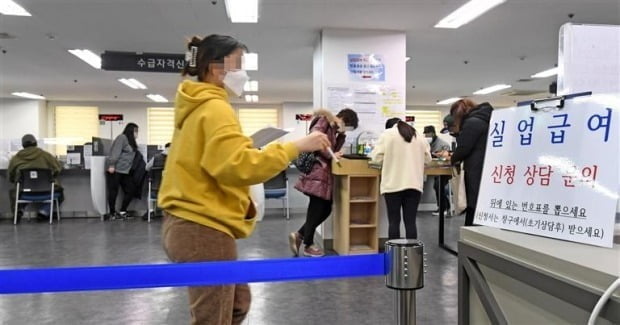
Photo = Hankyung DB
The number of unemployed workers who lost their jobs and applied for unemployment benefits in January of this year was counted at 212,000. The monthly record is the highest ever. It is interpreted that the third pandemic of the novel coronavirus infection (Corona 19) that has continued since the end of last year, the end of the usual year-end contract, and most of the public job programs have ended in December, and have applied for unemployment benefits in large numbers.
According to the “Labor Market Trends in January Employment Administration Statistics,” released by the Ministry of Employment and Labor on the 8th, the number of employees in employment insurance last month was 13835,000, an increase of only 151,000 from the same month last year. It is the minimum increase in 17 years since the increase of 138,000 in February 2004.
The decline in employment insurance subscriber growth was remarkable in the service industry. Last month, the number of subscribers to employment insurance in the service industry was 9433,000, an increase of 142,000 from the same month last year. Compared to November of last year, an increase of more than 410,000 from the same month of the previous year, the increase in subscribers was cut by a third in just two months. The impact of the end of public job programs was large.
Last month, the number of new unemployment benefits applicants increased by 38,000 from the record high in January last year (174,000). Despite the explosion of new applicants, the amount of unemployment benefits paid was 9602 billion won, less than 1 trillion won in the fourth month. The largest unemployment benefit payment in history was 1,188.5 billion won in July last year.
An official from the Ministry of Employment said, “Because the first month’s unemployment benefit is paid only for eight days, including the waiting period (7 days), the increased payment for new applicants will be reflected in the statistics of next month.”
Employment’triple bad news’… Accommodation and food for 50,000 people
Manufacturing supply declined for 3 consecutive years
The number of public administration jobs is the index that has the greatest impact on the increase or decrease of total employment insurance subscribers. Last year, the public job business was suspended until the second quarter due to the impact of Corona 19, but resumed in the third quarter, improving the employment administration statistics. Then, as the government and local governments’ public job programs were terminated at the end of the year, the overall employment index also deteriorated. This is why short-term public job projects continue to point out that they are distorting employment indicators.
Accommodation and food service, business service, and arts and sports were hit by the third corona 19 epidemic at the end of the year. In the lodging and food industry alone, 54,000 jobs were reduced, and 20,000 and 9,000 employment insurance subscribers disappeared in the business service and arts and sports industries, respectively. When looking at the number of tourists entering the country that are directly connected to the lodging industry, it plunged 99.1% from 1235,000 as of November 2019 to 12,000 in November of last year.
The number of employment insurance subscribers in the manufacturing industry continued to improve. The number of manufacturing jobs fell from -65,000 in July last year to a low, and the decline continued to decrease by 13,000 last month. Increasing demand for quarantine supplies such as masks led to an increase in jobs in the textile industry, and increased production of plastic packaging containers and sales of air purifiers, leading to an increase in employment insurance subscribers in the rubber and plastics industry and machinery equipment industry.
But the outlook is not optimistic. According to the ‘2020 4Q and Annual Manufacturing Domestic Supply Trend’ released by the National Statistical Office on that day, the manufacturing industry domestic supply index last year was 103.6, down 0.9% from the previous year. It has been decreasing for the third consecutive year since 2018. The domestic manufacturing supply index is an index that shows the value of manufacturing products produced or imported in Korea and supplied to the domestic market, showing trends in the domestic market.
The number of new applicants for unemployment benefits reached 212,000. The number increased by 38,000 from the previous year (174,000) in the previous year. The increase was mainly in public administration (29,000), business service (29,000), construction (26,000), and health and welfare (21,000).
Meanwhile, the Ministry of Employment and Labor decided to increase the number of 740 public officials who will be in charge of field work such as employment support in accordance with the implementation of the National Employment Support System last month. Hiring will take place in the second half. The size of such hiring is close to 10% of the current workforce of the Ministry of Employment (about 7500).
Reporter Baek Seung-hyun [email protected]
